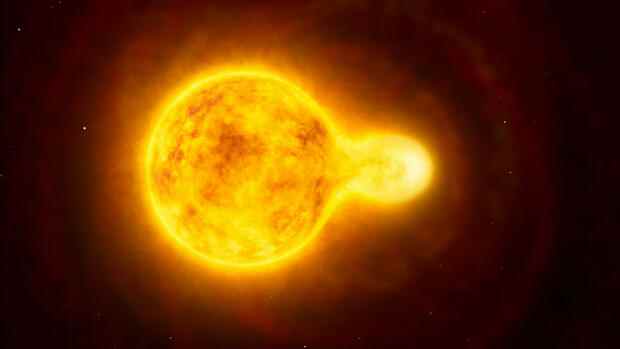Nuclear fusion is nothing less than the dream of an energy source like the sun – only on earth. (Illustration: ESO/dpa)
(Photo: dpa)
Berlin A new cooperation should bring nuclear fusion in Germany a big step forward. For this purpose, the start-up Marvel Fusion is teaming up with the laser center of the Ludwig-Maximilians-Universität (LMU), the Center for Advanced Laser Applications (Cala). The goal is the development of high-performance lasers for use in a nuclear fusion reactor, said Bavaria’s Science Minister Markus Blume (CSU) to the Handelsblatt.
The cooperation between the university and the start-up will be sealed this Thursday. Cala is considered a leader in laser research. Marvel Fusions has already raised 35 million euros in venture capital and is cooperating with companies such as Siemens and Trumpf.
The hopes are high: “For decades, environmentally friendly energy production with nuclear fusion was an abstract dream – now it can become concrete hope,” Blume continued. “There is a global race for new nuclear fusion approaches: There are around 35 projects, 30 of them in the USA – but so far not a single one in Germany.”
The minister demanded: “That has to change.” US President Joe Biden had just approved a multi-million dollar program for these innovative research projects. “I would wish that the federal government would also get involved here,” said the Minister of Science.
Top jobs of the day
Find the best jobs now and
be notified by email.
Nuclear fusion is based on the principle of the sun, in which energy is released when atoms fuse. In order to imitate this technologically, many billions have already flowed into fusion projects in recent decades. The most important is the Iter research reactor in southern France, which has been financed by an international cooperation since 2007. The EU alone has planned a good six billion euros for the period 2021 to 2027, the US government is expecting almost seven billion dollars.
>> Read also: The current energy crisis is driving up the cost of living. The federal government has now devised an instrument to protect customers and save companies at the same time
“But the Iter project will probably take many more years and will certainly not start before 2035. New approaches in nuclear fusion using laser-induced processes could massively shorten the time horizon,” Blume hopes.
In addition, the laser-triggered fusion of hydrogen and boron enables “clean nuclear fusion, since no enriched material is required compared to other processes and only harmless helium remains”. With the cooperation between Marvel Fusion and the LMU, “we are accelerating this exciting perspective for clean, sustainable energy production,” added the minister.
Bavaria supports the expansion of the laser research center Cala at the LMU with 2.5 million euros. The aim is to “make one of the world’s most powerful lasers even stronger”. The peak intensity of a single laser pulse would then be 1022 watts per square centimeter. “That’s a one followed by 22 zeros and corresponds to almost all of the solar power that hits the earth when it is focused to the size of a coin,” the minister explains the power. The laser pulse serves to compress matter so tightly that the fusion reaction starts
According to the ministry, Marvel Fusion is taking a new approach. Instead of “stadium-sized laser systems for compression ignition”, which works like a diesel engine, super-hot laser pulses are generated, which function somewhat like the spark plug in a petrol engine.
The news of a “near breakthrough” in laser nuclear fusion came last year from the USA: There, the National Ignition Facility (NIF) in California succeeded for the first time in the experiment in producing 70 percent of the energy that was previously put into it. Of course, this is by no means satisfactory, but it still represents enormous progress. Because until then never more than three percent had been achieved.
In this respect, the interim result is a “milestone in fusion research,” said laser fusion expert Markus Roth from the TU Darmstadt, who worked on the construction of the laser, to the magazine “Spektrum”.
More: The Munich start-up Marvel Fusion has secured the support of Siemens Trumpf and Thales and raised fresh capital

